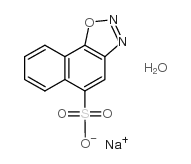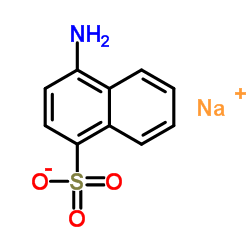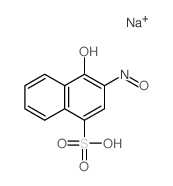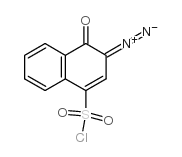64173-96-2
| 中文名 | 214 磺酸钠 |
|---|---|
| 英文名 | 2-Diazo-1-naphthol-4-sulfonate |
| 中文别名 |
214磺酸钠
2-重氮-1-萘酚-4-磺酸钠盐 3-重氮基-3,4-二氢-4-氧代-1-萘磺酸钠 1,2-萘醌-2-二叠氮基-4-磺酸钠 |
| 英文别名 |
SODIUM 1,2-NAPHTHOQUINONE-2-DIAZIDO-4-SULFONATE
4-(Natriumsulfo)-2-diazonio-naphtholat-(1) 2-DIAZO-1,2-NAPHTHOQUINONE-4-SULFONIC ACID SODIUM SALT Sodium 3-Diazo-3,4-dihydro-4-oxo-1-naphthalenesulfonate 2,1,4 Diazo Salt sodium 1-oxo-2-diazo-1,2-dihydrobenzene-4-sulfonate NAS-4 2-diazo-1-naphthoquinone-4-sulfonic acid sodium salt 1,2-Naphthochinondiazid-(2)-4-sulfonsaeure Natriumsalz EINECS 264-719-3 2-Diazo-1-naphthol-4-sulfonicacidsodiumsalt NSD SODIUM SALT MONOHYDRATE Diazo-2,1,4-sulfonic acid sodium salt MFCD02091674 Naphthoquinonediazidosulfonicacidsodiumsalt |
| 密度 | 9.53 |
|---|---|
| 沸点 | 1470 °C |
| 熔点 | 886 °C(lit.) |
| 分子式 | C10H7N2NaO5S |
| 分子量 | 290.22800 |
| 精确质量 | 289.99700 |
| PSA | 113.73000 |
| LogP | 2.29660 |
| 折射率 | 2.67 |
| 储存条件 | 存放容器内,并放在阴凉,干燥处。储存的地方必须远离氧化剂,避光,室温保存。 |
| 稳定性 | 远离氧化物,强酸,阳光,热,明火,高温,火花,静电电荷,其他点火源。 |
| 计算化学 | 1.疏水参数计算参考值(XlogP):无 2.氢键供体数量:0 3.氢键受体数量:5 4.可旋转化学键数量:0 5.互变异构体数量:无 6.拓扑分子极性表面积117 7.重原子数量:18 8.表面电荷:0 9.复杂度:422 10.同位素原子数量:0 11.确定原子立构中心数量:0 12.不确定原子立构中心数量:0 13.确定化学键立构中心数量:0 14.不确定化学键立构中心数量:0 15.共价键单元数量:2 |
| 更多 | 1. 性状:黄色结晶性粉末。 2. 密度(g/mL,25/4℃):未确定 3. 相对蒸汽密度(g/mL,空气=1):未确定 4. 熔点(ºC):未确定 5. 沸点(ºC,常压):未确定 6. 沸点(ºC,5.2kPa):未确定 7. 折射率:未确定 8. 闪点(ºC):未确定 9. 比旋光度(º):未确定 10. 自燃点或引燃温度(ºC):未确定 11. 蒸气压(kPa,25ºC):未确定 12. 饱和蒸气压(kPa,60ºC):未确定 13. 燃烧热(KJ/mol):未确定 14. 临界温度(ºC):未确定 15. 临界压力(KPa):未确定 16. 油水(辛醇/水)分配系数的对数值:未确定 17. 爆炸上限(%,V/V):未确定 18. 爆炸下限(%,V/V):未确定 19. 溶解性:溶于水。 |
|
Sodium 1,2-Naphthoquinone-2-diazido-4-sulfonate
Revision number: 5
SAFETY DATA SHEET Section1. IDENTIFICATION Product name:Sodium 1,2-Naphthoquinone-2-diazido-4-sulfonate Revision number:5 Section2. HAZARDS IDENTIFICATION GHS classification PHYSICAL HAZARDS Type D Self-reactive substances and mixtures HEALTH HAZARDS Category 2 Skin corrosion/irritation Serious eye damage/eye irritationCategory 2A Not classified ENVIRONMENTAL HAZARDS GHS label elements, including precautionary statements Pictograms or hazard symbols Signal wordDanger Hazard statementsHeating may cause a fire Causes skin irritation Causes serious eye irritation Precautionary statements: Keep away from heat/sparks/open flames/hot surfaces. - No smoking. [Prevention] Keep away from incompatible materials such as oxidizing agents. Keep only in original container. Wash hands thoroughly after handling. Wear protective gloves/eye protection/face protection. [Response]IF IN EYES: Rinse cautiously with water for several minutes. Remove contact lenses, if present and easy to do. Continue rinsing. If eye irritation persists: Get medical advice/attention. IF ON SKIN: Gently wash with plenty of soap and water. If skin irritation occurs: Get medical advice/attention. Take off contaminated clothing and wash before reuse. [Storage]Store away from other materials. Store in a well-ventilated place. Keep cool. [Disposal]Dispose of contents/container through a waste management company authorized by the local government. Section3. COMPOSITION/INFORMATION ON INGREDIENTS Substance Substance/mixture: Sodium 1,2-Naphthoquinone-2-diazido-4- sulfonate Section3. COMPOSITION/INFORMATION ON INGREDIENTS Components:Sodium 1,2-Naphthoquinone-2-diazido-4-sulfonate Percent:>97.0%(LC)(T) CAS Number:64173-96-2 Synonyms:1,2-Naphthoquinone-2-diazido-4-sulfonic Acid Sodium Salt , Sodium 3-Diazo-3,4- dihydro-4-oxo-1-naphthalenesulfonate , 3-Diazo-3,4-dihydro-4-oxo-1- naphthalenesulfonic Acid Sodium Salt Chemical Formula:C10H5N2NaO4S Section4. FIRST AID MEASURES Inhalation:Remove victim to fresh air and keep at rest in a position comfortable for breathing. Get medical advice/attention if you feel unwell. Skin contact:Remove/Take off immediately all contaminated clothing. Gently wash with plenty of soap and water. If skin irritation or rash occurs: Get medical advice/attention. Eye contact:Rinse cautiously with water for several minutes. Remove contact lenses, if present and easy to do. Continue rinsing. If eye irritation persists: Get medical advice/attention. Ingestion:Get medical advice/attention if you feel unwell. Rinse mouth. A rescuer should wear personal protective equipment, such as rubber gloves and air- Protection of first-aiders: tight goggles. Section5. FIRE-FIGHTING MEASURES Suitable extinguishingDry chemical, foam, water spray, carbon dioxide. media: Specific hazards arising Explosion risk in case of fire. Fight fire remotely due to the risk of explosion. from the chemical:Take care as it may decompose upon combustion or in high temperatures to generate poisonous fume. Precautions for firefighters: Fire-extinguishing work is done from the windward and the suitable fire-extinguishing method according to the surrounding situation is used. Uninvolved persons should evacuate to a safe place. In case of fire in the surroundings: Keep containers cool by spraying with water. Eliminate all ignition sources if safe to do so. When extinguishing fire, be sure to wear personal protective equipment. Special protective equipment for firefighters: Section6. ACCIDENTAL RELEASE MEASURES Personal precautions,Use personal protective equipment. Keep people away from and upwind of spill/leak. protective equipment and Entry to non-involved personnel should be controlled around the leakage area by emergency procedures: roping off, etc. Environmental precautions: Prevent product from entering drains. Methods and materials for Sweep dust to collect it into an airtight container, taking care not to disperse it. containment and cleaning Adhered or collected material should be promptly disposed of, in accordance with up: appropriate laws and regulations. Prevention of secondary Remove all sources of ignition. Fire-extinguishing devices should be prepared in hazards:case of a fire. Use spark-proof tools and explosion-proof equipment. Section7. HANDLING AND STORAGE Precautions for safe handling Technical measures:Handling is performed in a well ventilated place. Wear suitable protective equipment. Be careful not to cause leakage, overflow, or dispersion. Steam should not be generated unnecessarily. Keep away from heat/sparks/open flame/hot surfaces. -No smoking. Take measures to prevent the build up of electrostatic charge. Use explosion-proof equipment. Avoid shock and friction. Wash hands and face before breaks and immediately after handling the product. Use a local exhaust if dust or aerosol will be generated. Avoid contact with skin, eyes and clothing. Advice on safe handling: Sodium 1,2-Naphthoquinone-2-diazido-4- sulfonate Section7. HANDLING AND STORAGE Conditions for safe storage, including any incompatibilities Storage conditions:Keep container tightly closed. Store in a cool, dark and well-ventilated place. Be sure not to give the container unexpected impacts, such as falling down or falling off. Store away from other materials. Packaging material:Comply with laws. Keep only in original container. Section8. EXPOSURE CONTROLS / PERSONAL PROTECTION Engineering controls:Install a closed system or local exhaust as possible so that workers should not be exposed directly. Also install safety shower and eye bath. Personal protective equipment Respiratory protection: Dust respirator. Follow local and national regulations. Hand protection:Protective gloves. Safety glasses. A face-shield, if the situation requires. Eye protection: Skin and body protection: Protective clothing. Protective boots, if the situation requires. Section9. PHYSICAL AND CHEMICAL PROPERTIES Solid Physical state (20°C): Form:Crystal- Powder Colour:Reddish yellow - Deep yellow red No data available Odour: pH: No data available Melting point/freezing point:No data available Boiling point/range:No data available No data available Flash point: Flammability or explosive limits: Lower:No data available No data available Upper: Relative density:No data available Solubility(ies): [Water]No data available No data available [Other solvents] Section10. STABILITY AND REACTIVITY Chemical stability:Stable under proper conditions. Possibility of hazardous May explosively decompose on heating, shock, friction, etc. reactions: Conditions to avoid:Heat, Spark, Open flame, Shock, Friction Incompatible materials: Oxidizing agents Hazardous decomposition Carbon monoxide, Carbon dioxide, Nitrogen oxides (NOx), Sulfur oxides products: Section11. TOXICOLOGICAL INFORMATION Acute Toxicity:No data available Skin corrosion/irritation: No data available Serious eyeNo data available damage/irritation: Germ cell mutagenicity: No data available Carcinogenicity: IARC =No data available No data available NTP = Reproductive toxicity:No data available Sodium 1,2-Naphthoquinone-2-diazido-4- sulfonate Section12. ECOLOGICAL INFORMATION Ecotoxicity: Fish:No data available Crustacea:No data available Algae:No data available Persistence / degradability: No data available BioaccumulativeNo data available potential(BCF): Mobility in soil Log Pow:No data available Soil adsorption (Koc):No data available Henry's LawNo data available constant(PaM3/mol): Section13. DISPOSAL CONSIDERATIONS Recycle to process, if possible. Consult your local regional authorities and an expert of disposal. You may be able to dissolve or mix material with a combustible solvent and little by little burn in a chemical incinerator equipped with an afterburner and scrubber system. If a large amount of the substance is burned at a time, an explosion may occur. Observe all federal, state and local regulations when disposing of the substance. Section14. TRANSPORT INFORMATION Hazards Class:4.1: Flammable solid. UN-No:3226 Proper shipping name:Self-reactive solid type D Section15. REGULATORY INFORMATION Safe management ordinance of dangerous chemical product (State Council announces on January 26, 2002 and revised on February 16,2011): Safe use and production, the storage of a dangerous chemical, transport, loading and unloading were prescribed. SECTION 16 - ADDITIONAL INFORMATION N/A |
| 危害码 (欧洲) | T,N |
|---|---|
| 风险声明 (欧洲) | R61:May cause harm to the unborn child. R20/22:Harmful by inhalation and if swallowed . R33:Danger of cumulative effects. R50/53:Very Toxic to aquatic organisms, may cause long-term adverse effects in the aquatic environment . R62:Possible risk of impaired |
| 安全声明 (欧洲) | S53-S45-S60-S61 |
| 危险品运输编码 | UN 2291 6.1/PG 3 |
| WGK德国 | 3 |
| RTECS号 | OG1750000 |
| 包装等级 | III |
| 危险类别 | 6.1(b) |
|
~60% 
64173-96-2 |
| 文献:Sauer, E.; Polz, K.; Schopf, G.; Bendig, J. Journal fuer Praktische Chemie (Leipzig), 1991 , vol. 333, # 3 p. 467 - 473 |
|
~% 
64173-96-2 |
| 文献:Journal fuer Praktische Chemie (Leipzig), , vol. 333, # 3 p. 467 - 473 |
|
~% 
64173-96-2 |
| 文献:Journal fuer Praktische Chemie (Leipzig), , vol. 333, # 3 p. 467 - 473 |
|
~% 
64173-96-2 |
| 文献:Journal fuer Praktische Chemie (Leipzig), , vol. 333, # 3 p. 467 - 473 |
| 上游产品 4 | |
|---|---|
| 下游产品 1 | |




